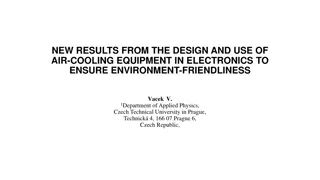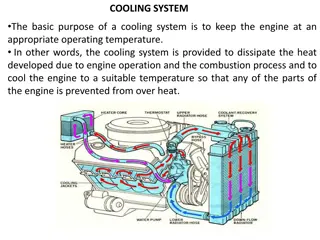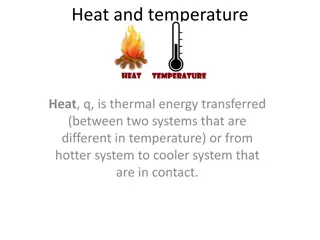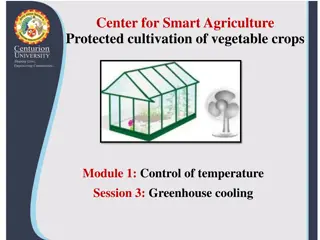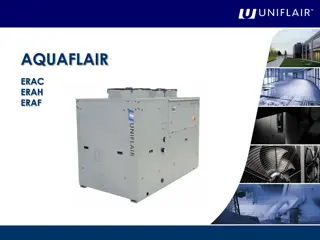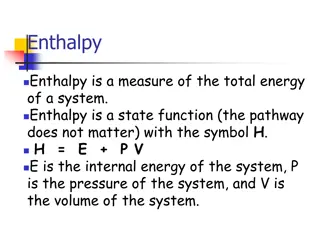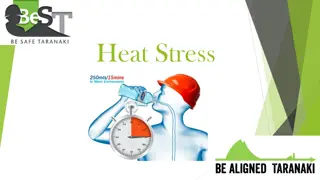Green Chemistry and Desert Heat: Cooling Techniques and Sustainability
Dealing with excessive heat in hot environments requires understanding key chemistry concepts and implementing sustainable cooling technologies. Explore how sweating helps regulate body temperature and learn about the effectiveness of evaporative cooling through latent heat of vaporization.
Download Presentation

Please find below an Image/Link to download the presentation.
The content on the website is provided AS IS for your information and personal use only. It may not be sold, licensed, or shared on other websites without obtaining consent from the author.If you encounter any issues during the download, it is possible that the publisher has removed the file from their server.
You are allowed to download the files provided on this website for personal or commercial use, subject to the condition that they are used lawfully. All files are the property of their respective owners.
The content on the website is provided AS IS for your information and personal use only. It may not be sold, licensed, or shared on other websites without obtaining consent from the author.
E N D
Presentation Transcript
These slides contain animations, when the PowerPoint file is played The content gradually appears with clicks Questions appear before their answers
Green Chemistry and Living in the Desert Heat Avoiding it, Removing it Light matter interactions IR and Heat Cooling drinks - ice inside, condensation outside Cooling me - Shade, Sweat, Humidity, Cooling breeze Cooling our space Refrigeration and AC Refrigerant problems - Ozone layer, Greenhouse effect
Heat Dealing with heat (too much) is a major issue for humans living in a hot environment Chemistry concepts are critical to understanding how cooling processes work, relevant topics include gas laws, vapor pressure, boiling point, heat of vaporization, phase changes, latent heat, heat capacity. Green Chemistry and Sustainability ideas are relevant to the energy consumed and the nature of potentially polluting materials used with various cooling technologies
Sweating Humans are mammals. We are warm-blooded meaning that our body temperature must be very tightly regulated for us to survive. Our body temperature needs to be right around 37 C, but in summer in the desert the temperature is often over 40 C and sometimes closer to 50 C! Yet we can survive just fine. Our cooling system relies on evaporating water to remove heat.
Sweating Sweating How does it work? Sweating is a very effective method of cooling us down, but what are the physical/chemical principles that allow it to work? We know that sweating works by evaporation, or evaporative cooling. But what does that mean?
Sweating Evaporative cooling This relies on a phenomenon called latent heat of vaporization That is the energy required to convert a liquid to a gas For example, when water reaches 100 C further heat input does not raise the temperature of the sample until all of the water has converted from liquid into gas (steam). Further heating then raises the temperature of the steam.
Sweating Evaporative cooling This relies on a phenomenon called latent heat of vaporization That is the energy required to convert a liquid to a gas We can see this effect in action if we take a pot of water, put a thermometer in it, and boil it. If we apply a constant heat supply (e.g. a gas flame) the temperature will be seen to steadily rise. At some point the water starts boiling and continues to do so until all the water is gone. During boiling the temperature of the water does not change (100 C), all the energy being absorbed is used to convert the liquid to gas.
Sweating Examining the case of boiling water makes it easy to observe and measure the latent heat of vaporization However, importantly, evaporation occurs at any temperature, with its associated latent heat absorption The boiling point is just the special case where the vapor pressure matches the external pressure In the case of sweating, the evaporation is occurring at near body temperature (37 C) Energy numbers have been measured and are well-known, we can calculate how much water is needed to cause a particular amount of cooling.
Sweating At 37 C the heat of vaporization of water is 2413 kJ/kg The heat capacity of liquid water is 4.18 kJ/kg Example Let s say we have a cyclist who weighs 70 kg and rides at 200 W (1 watt = 1 joule/second) for 1 h. Humans are not that efficient at converting our chemical energy to work. So, for that 200 W of work, the cyclist also produces 800 W of heat. Energy = power x time. Energy = 800 W x 1 h 0.8 kwh = 2880 kJ of waste heat was produced Waste heat (2880)/heat of vap. of water (2413) = 1.19 kg = 1.19 L of water needs to evaporate to remove the heat produced
Sweating At 37 C the heat of vaporization of water is 2413 kJ/kg The heat capacity of liquid water is 4.18 kJ/kg 2880/2413 = 1.19 kg = 1.19 L of water needs to evaporate to remove the heat produced Probably more than this much sweat will be needed. Why? 1. Not all of the sweat evaporates! If it drips off it s not cooling you! 2. none of this heat was lost ? How high would the cyclist s body temperature be raised if Humans are largely made of water. So, let's assume that that this person has the same heat capacity as an equivalent weight of water 4.18 kJ/kg 4.18 kJ/kg x 70 kg = 292.6 kJ needed to raise the cyclist s temp by 1 C Temp increase with no cooling = 2880 kJ (heat produced)/292.6 = 9.8 C (leading to death!)
Sweating But there are limits to how much cooling can be done with sweating Effect of Humidity Water will only evaporate to the extent that more water vapor can be added to the air. That is, until the vapor pressure of water at that temperature is reached. Another way to say this is that if the air is at 100% humidity, then no evaporation will occur = no cooling effect from sweating This is why hot weather is so much more uncomfortable when the humidity is high. Many circumstances lead to 100% humidity in the air. As water condenses, we see clouds and fog, and eventually rain, dew, snow etc.


